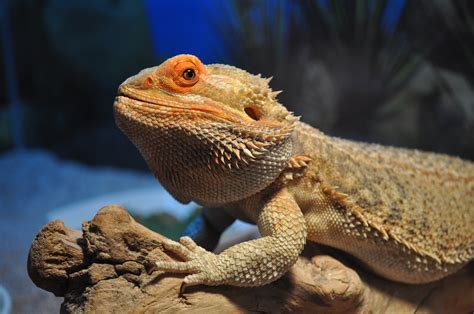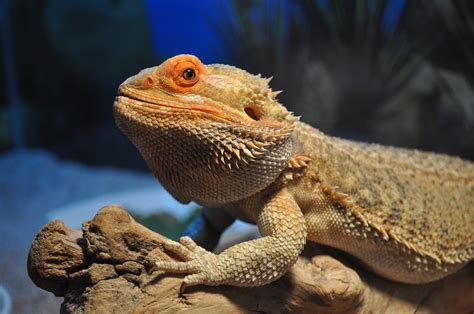

Bearded dragons are fascinating reptiles that make great pets. Learn about their care, diet, and behavior in our comprehensive guide.
As a popular pet among reptile enthusiasts, the bearded dragon has gained quite the reputation for its friendly demeanor and unique appearance. With its scaly exterior and impressive beard-like protrusion under its chin, this lizard has become a beloved addition to many households. However, there is much more to these creatures than meets the eye. Not only are they fascinating to observe, but they also make for interesting study subjects due to their ability to adapt to various environments. So, whether you’re a seasoned reptile owner or simply curious about these cold-blooded critters, read on to discover what makes the bearded dragon such a remarkable creature.
Daftar Isi
A Brief Introduction to the Bearded Dragon
The bearded dragon, also known as Pogona, is a type of lizard native to Australia. It is a popular pet and is known for its docile nature and unique appearance. While there are several species of bearded dragons, the most commonly kept species is the inland bearded dragon.
Appearance and Characteristics
Size
Bearded dragons can grow up to two feet in length, with males typically being larger than females. They have a stocky build and are covered in bumpy, armor-like scales. Their most distinctive feature is their beard, which they puff out when threatened or displaying dominance.
Coloration
Bearded dragons come in a range of colors including shades of brown, tan, and reddish-orange. Some individuals may also have patterns or stripes on their scales. The color of their scales can change depending on their mood or temperature.
Habitat and Diet
In the wild, bearded dragons live in the arid regions of Australia. They are omnivores and eat a varied diet of insects, vegetables, and fruits. In captivity, they require a large enclosure with a heat source and UV lighting to replicate their natural habitat. A balanced diet consisting of live insects and vegetables is essential for their health.
Caring for a Bearded Dragon
Enclosure
A minimum enclosure size for one bearded dragon is 40 gallons, but a larger enclosure is recommended. They require a basking area with a heat lamp and a cooler area to regulate their body temperature. A substrate such as reptile carpet or tiles should be used for the enclosure floor.
Lighting and Temperature
Bearded dragons require UVB lighting to synthesize vitamin D3, which is essential for their bone health. The temperature of the enclosure should range from 75-85 degrees Fahrenheit on the cooler side and 100-110 degrees Fahrenheit on the basking side.
Diet
A varied diet consisting of live insects such as crickets, mealworms, and dubia roaches as well as vegetables such as collard greens, squash, and carrots is important for a bearded dragon’s health. Younger dragons require more protein than adults and should be fed more insects.
Handling
Bearded dragons are generally docile and can be handled with care. It is important to support their body and avoid grabbing their tail, which can cause injury. They should also be handled regularly to become accustomed to human interaction.
Health Concerns
Metabolic Bone Disease
Metabolic bone disease is a common health concern in bearded dragons. It is caused by a lack of calcium and vitamin D3 in their diet and can lead to skeletal abnormalities. Providing a proper diet and UVB lighting can prevent this disease.
Parasites
Bearded dragons can become infected with internal parasites such as pinworms and coccidia. Regular fecal examinations and deworming treatments can prevent parasite infections.
Respiratory Infections
Respiratory infections can occur in bearded dragons due to inadequate temperatures or poor hygiene. Symptoms include wheezing, discharge from the nostrils or mouth, and lethargy. A veterinarian should be consulted if a respiratory infection is suspected.
Conclusion
Bearded dragons are fascinating reptiles that make great pets. Proper care is essential for their health and well-being. With a balanced diet, appropriate lighting and temperature, and regular veterinary care, bearded dragons can live long and healthy lives.
Introduction: What is a Bearded Dragon?
Bearded Dragons are small, desert-dwelling lizards native to Australia. They get their name from the beard of spiny scales around their necks. In recent years, Bearded Dragons have become increasingly popular as pets.
Appearance and Size:
Bearded Dragons can grow up to two feet in length, with males typically slightly larger than females. They have a distinctive triangular head and flat body covered in small, spiny scales. Their coloring can vary from tan to reddish-brown, with some having markings or patterns.
Habitat:
In the wild, Bearded Dragons are found in the arid interior regions of Australia. They inhabit rocky desert areas and open woodlands, and often hide in crevices or under rocks during the hottest parts of the day. In captivity, they require a warm, dry environment with access to UVB lighting.
Temperament:
Bearded Dragons are known for their docile nature and are a favorite pet among families with children. They are generally easy to handle and are not usually aggressive. They also have a unique personality; some owners describe their Bearded Dragons as curious or even playful.
Diet:
Bearded Dragons are omnivorous, meaning they eat both plants and animals. In captivity, they can be fed a diet of insects such as crickets, as well as vegetables and fruit. It’s important to ensure they receive all necessary nutrients in their diet.
Care and Maintenance:
Despite their easy temperament, Bearded Dragons do require some specialized care and maintenance. They need a warm, dry environment with access to UVB lighting, and a diet that provides necessary nutrients. Regular cleaning of their enclosure is also important for their health and well-being.
Health Concerns:
Bearded Dragons can be prone to certain health issues, including metabolic bone disease and respiratory infections. Regular check-ups with a veterinarian who specializes in reptiles are recommended. It’s important to monitor their appetite, behavior, and overall health to catch any issues early.
Breeding:
Bearded Dragons can be bred in captivity, but it requires specific conditions and care. Breeding can be a complex and time-consuming process, and should only be attempted by experienced owners. It’s also important to consider the potential impact on the population of Bearded Dragons.
Legal Considerations:
In some areas, owning a Bearded Dragon may be restricted or require a permit. Owners should check with their local authorities to ensure they are complying with all applicable laws and regulations.
Conclusion:
Bearded Dragons make fascinating and rewarding pets for those who are willing to provide them with the care and environment they need. With their unique personalities and striking appearance, they are sure to be a conversation starter wherever they go.
Bearded dragons are a type of reptile that have become increasingly popular as pets in recent years. These creatures are known for their unique, spiky appearance, docile nature, and relatively low-maintenance care requirements. However, like any pet, there are pros and cons to owning a bearded dragon.
The Pros of Owning a Bearded Dragon
- Low-Maintenance: Bearded dragons are relatively easy to care for and don’t require a lot of attention. They only need to be fed once a day and their enclosure needs to be cleaned once a week.
- Docile Nature: Bearded dragons are known for their friendly and docile demeanor. They rarely bite and enjoy being handled by their owners.
- Long Lifespan: Bearded dragons can live up to 15 years with proper care, making them a long-term pet option.
- Interactive: Bearded dragons are social creatures and enjoy interacting with their owners. They will often sit on their owner’s lap or shoulder and even play games.
- Education: Owning a bearded dragon can be educational for children and adults alike. It can teach responsibility, animal behavior, and biology.
The Cons of Owning a Bearded Dragon
- Cost: Bearded dragons can be expensive to purchase, and their enclosure setup can also be costly.
- Specialized Diet: Bearded dragons require a specialized diet that includes live insects and vegetables. This can be inconvenient and expensive to maintain.
- Health Issues: Bearded dragons are susceptible to certain health issues such as metabolic bone disease and respiratory infections. Regular vet check-ups are necessary to prevent and treat these issues.
- Space Requirements: Bearded dragons require a large enclosure to live comfortably and thrive. This can be an issue for those with limited space in their home.
- Lifespan: While the long lifespan of a bearded dragon can be a pro, it can also be a con. Owners need to be prepared for the long-term commitment of caring for a pet that can live up to 15 years.
Overall, owning a bearded dragon can be a rewarding experience for those willing to put in the time, effort, and financial investment required. However, it’s important to weigh the pros and cons before making a decision to bring one into your home.
Bearded dragons are fascinating creatures that have captured the hearts of many pet lovers. These reptiles are native to Australia and are known for their unique appearance, docile nature, and easy-to-care-for habits. If you’re considering getting a bearded dragon as a pet, there are a few things you should know to ensure that you provide them with the best possible care.
First and foremost, it’s important to create a suitable habitat for your bearded dragon. They require a warm and dry environment, so a terrarium with a heat lamp and UVB light is essential. Bearded dragons also need a place to bask, so providing a rock or log for them to climb on is ideal. Additionally, they require a varied diet consisting of insects, vegetables, and fruits.
It’s also important to handle your bearded dragon properly. While they are generally friendly and docile, they can become stressed if handled too roughly or too often. It’s best to handle them for short periods of time and allow them to rest in their terrarium when they need to. Lastly, regular visits to the veterinarian are crucial for maintaining your bearded dragon’s health and well-being.
In conclusion, bearded dragons make wonderful pets for those who are willing to put in the time and effort to care for them properly. With the right habitat, diet, and handling techniques, you can provide your bearded dragon with a happy and healthy life. If you’re considering getting a bearded dragon, be sure to do your research and consult with a veterinarian to ensure that you’re prepared to provide them with the best possible care.
Video bearded dragon
As a journalist, it is important to provide valuable information to our readers. One popular topic among pet owners is the bearded dragon. Here are some of the most frequently asked questions about these fascinating creatures:
1. What is a bearded dragon?
A bearded dragon is a type of lizard that is native to Australia. They are named for the spiny scales on their throat that puff up when they feel threatened, making them resemble a beard.
2. Are bearded dragons good pets?
Yes, bearded dragons can make great pets. They are docile, easy to care for, and have unique personalities. However, they do require specific habitats, diet, and temperature requirements, so be sure to do your research before bringing one home.
3. What do bearded dragons eat?
Bearded dragons are omnivores and eat a variety of foods including insects, vegetables, and fruit. A balanced diet should consist of 60% insects and 40% plant matter.
4. How big do bearded dragons get?
Bearded dragons can grow to be up to two feet long, with males typically being larger than females.
5. How do you care for a bearded dragon?
To care for a bearded dragon, you will need to provide them with a properly sized habitat, UVB lighting, and a heat source. You will also need to feed them a balanced diet and keep their habitat clean and well-maintained.
By answering these frequently asked questions, we hope to provide pet owners with valuable information about caring for their bearded dragons.






